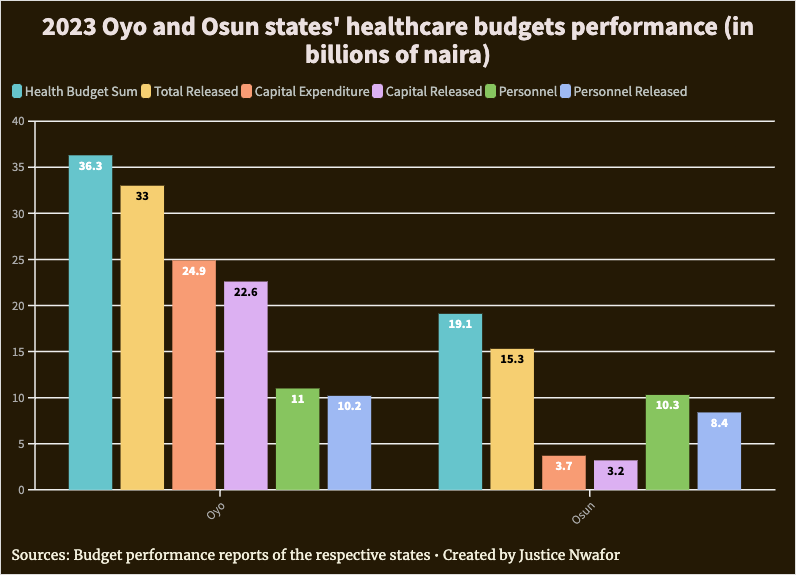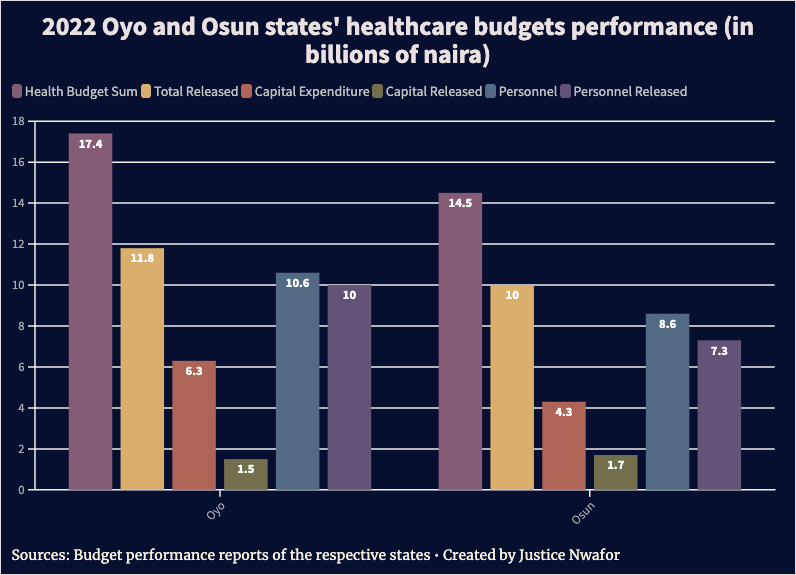Healthcare Funding: Data Reveal Inadequate Health Budget Performance in Oyo and Osun
Governors Seyi Makinde and Adeleke at an event recetly
By Justice Nwafor
Inadequate healthcare funding is a known challenge in Nigeria, especially at the sub-national level. However, what is largely unknown is how the healthcare budgets at the state level, especially in the southwest of the country, perform.
Data has, therefore, revealed that despite the inadequate amount states budget for healthcare, they fail to release all for implementation. To unravel this, this reporter obtained and analyzed the 2022 and 2023 healthcare budget performance data of Oyo and Osun states.
In Nigeria, Oyo State is popular for many things: its large population of over 8 million, the large size of its capital city, Ibadan, the presence of old institutions in the state, and more. But the state needs to catch up on issues like inadequate personnel for the over 2,000 healthcare facilities distributed across the three tiers of healthcare. While the over 2000 facilities may seem fair, some of them, especially those in far-flung communities, are not just old and poorly maintained but also need more adequate equipment and facilities for smooth operation.
For instance, Adegbite Memorial Hospital, Igbo-Oloyin, categorized as a comprehensive healthcare facility and run by the Oyo State Hospitals Management Board, had just a few bed spaces for patients. The hospital had no operating table and other important facilities for surgical operation and baby delivery, according to this report.

Impressive Allocation, Poor Releases
So, in 2022, when the state decided to allocate N17.4 billion to health, up from N13.7 billion it allocated in 2021, many saw it as not entirely enough but an improvement.
Another state in the region, Osun, with its share of challenges, budgeted N14.5 billion for healthcare in the same year.
However, the two states failed to release the entire budgeted sum for implementation: Oyo State released N11.8 billion or 67.7%, while Osun State released N10 billion or 69.3%.
Iniobong Usen is the Head of Research and Policy Advisory at BudgIT. He told this reporter that one of the ways to know which sectors are at the top of the priority list of any state government is not just by looking at the amount of funds it allocates to them, but by the amount it makes available for implementation.
He explained that even when a government does not have enough, it could borrow to implement budgets for ministries, agencies, or sectors that it deems important. He added that health should be among those on the priority list of any government.
In 2023, Oyo State more than doubled the 2022 figures: it budgeted N36.3 billion and Osun State followed suit with N19.1 billion for 2023, though not up to a double of its 2022 figures. There were clear improvements. Experts say the improvement was not just for health. Nearly all sectors received more money. Here’s why: the general budget for the states improved: Oyo state jumped from N294.7 billion annual budget in 2022 to N352.2 billion in 2023 while Osun jumped from N129.7 billion in 2022 to N168.1 billion in 2023.
This shows that the states got more money in 2023. Why? When Nigeria’s current president took over office a year ago, he scrapped subsidies on petrol. This led to savings for the government and more money became available to share between the federal, state, and local governments. For instance, in October 2023, the three tiers of government shared N906.9 billion compared to N736.782 billion they shared in October 2022.
So, the states had more money to spend, and it was normal that they increased the budget for health. Implementation of the budget is where the problem lies. None of the states released the entire budgeted amount for the two years under review.
For Oyo State, N33 billion or 91.0% of the 2023 budget, was released, while in Osun State, N15.3 billion or 80.2% of the 2023 amount, was released.
Beyond the budget sum and performance, one of the major problems of healthcare in Nigeria is low investment capital development.
In budgeting terms, there are recurrent and capital expenditures. Recurrent expenditure encapsulates expenses under personnel and overhead costs, while capital expenditure holds the cost of capital development like building and renovation of facilities.
Recurrent Ahead of Capex
In Oyo State’s 2022 health budget, N6.3 billion was allocated for capital expenditure (capex), but N1.5 billion or 24.1%, was released, while N10.6 billion was allocated for personnel costs and N421 million for overhead costs. Personnel costs had an impressive performance of 94.4% (N10 billion was released), while overhead had a 43.5% performance (N183.2 million was released).

The next year, Oyo’s capex budget was N24.9 billion, and N22.6 billion, or 91.0% of the amount was released. Personnel cost was N11 billion and overhead was N362 million. N10.2 billion or 92.3% was released for personnel and N163.9 million or 45.2% for overhead.
Analysis shows that despite the differences in budgeted and released amounts, personnel performned better than capital in terms of the percentage of releases.
The same trajectory was also evident in Osun. In 2022, the health budget for Capex was N4.3 billion but only N1.7 billion or 40.4% of the amount, was released. For personnel, N8.6 billion was budgeted, and N1.6 billion for overhead. Personnel got N7.3 billion or 85.9% of the amount released while overhead got N959.7 million or 59.0% released.
The next year, it got worse: N3.7 billion was budgeted for capex, N10.3 billion for personnel and N3.8 billion for overhead. N3.2 billion or 86.4% was released for capex, N8.4 billion, or 81.5% for personnel, and N2.5 billion, or 64.7% for overhead.
For Usen, budget failure is also a product of poor planning. While issues like “leakages within the system”, corruption, inadequate resources, and poor project planning contribute to poor budget implementation, he says governments at all levels have a responsibility to ensure that budgets perform well and health gets the attention it deserves.
“Are the figures the government put forward in the budget realistic?”, he queries. “If the govt does not have realistic projections for its macroeconomic indicators, the budget performance will be poor. You find a number of states that have lofty plans that are not backed up by resources.”


